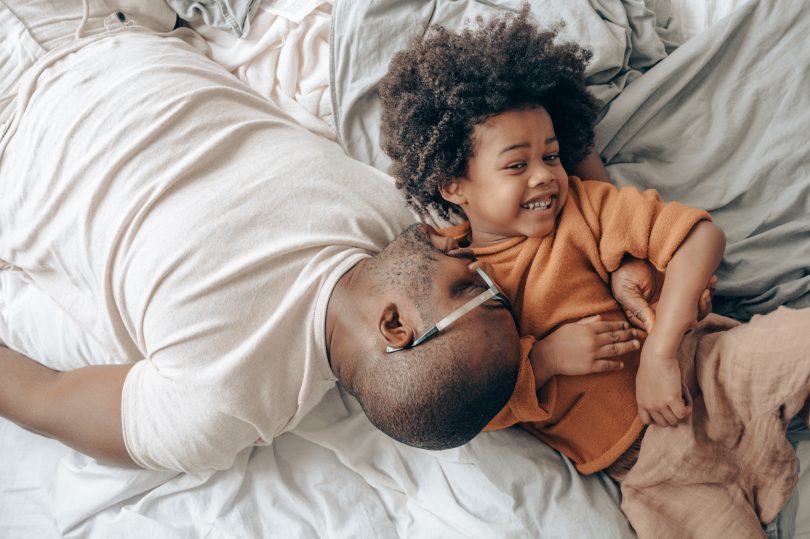Ease the challenges of co-parenting with these tips for creating a good sleep routine for your child.
One of the effects of divorce or separation that isn’t often discussed is the impact on your childrens’ sleep schedules.
The anxiety and stress of the change, as well as sleeping in a different environment some of the time can keep even the most consistent sleeper awake. Your kids might have trouble falling asleep, awaken throughout the night, or start having bad dreams and nightmares when they never did before.
But as their parent, you want them to have healthy, restful sleep, and that begins with working with your ex-partner or spouse to develop healthy sleep habits and provide reassurance.
“But Dad lets me!”
As anyone in the throes of co-parenting can attest, it’s practically inevitable that the rules will be different at one parent’s house — and when the kids return to the other parent, things can go sideways rather quickly.
It might be that a strict bedtime is enforced by one parent, while the other is more lax and allows the kids to stay up to watch movies or play games. Or perhaps one parent allows the child to co-sleep, while the other insists that kids sleep in their own beds.
Regardless of where the disconnect occurs, the ultimate effect is more conflict between you and your ex, and challenges with your kids’ sleep routines. When one parent is more lenient with the rules, kids may use that against the other in an attempt to get their own way. With that in mind, consistency is key, with both of you agreeing on a consistent set of rules, and enforcing them equally.
This, of course, can be challenging when there is conflict between the two of you, but it’s vital to put your feelings aside in order to do what’s best for the kids.
Although neither of you can control what happens in the others’ home, and there may be aspects of their parenting approach you don’t completely agree with, coming to an agreement on basic guidelines can help maintain healthy sleep habits.
These agreements might include establishing a bedtime, naptime, what the kids can bring to bed (for example, can they bring a drink to bed?), and guidelines about co-sleeping.
Even better is working with your ex to establish a consistent bedtime routine for both homes. For example, if your ex typically gives your little one a bath and then reads stories before bed, commit to doing the same at your house.
The more similar your routines are to each other, the easier it’s going to be for your child to feel comfortable and get to sleep.
Create a sense of safety
For many children, sleeping in an unfamiliar environment disrupts their sleep routine. And when they only sleep in that space part-time, it takes longer for them to get comfortable.
Both parents should commit to creating a safe and comfortable sleeping environment.
This means creating environments that are as similar as possible in both homes. For example, if your child has a white noise machine and nightlight at mom’s house, then they should also have one at dad’s.
When traveling between homes, make sure they have items like security blankets or favourite stuffed animals to help them get to sleep. Although having similar bedding is nice, it doesn’t have to be identical. Consider taking your child shopping for new bedding or bedroom decor so they feel like they have some control over their space and it’s “theirs.”
Some children might have concerns about safety when it comes to staying in an unfamiliar place. It could be feelings associated with staying in a new house, or with sleeping without both parents nearby. Although time will likely lessen these concerns, you can also help your child feel reassured by incorporating security into their bedtime routine.
For example, have them help you lock doors and windows so they can be sure that they are safe and secure. At the same time, if your child doesn’t express concerns about safety, don’t make a fuss about these things. Making a big show of locking the doors before bed can trigger fears that weren’t present and cause sleep issues.
Keep lines of communication open
The demise of your relationship can create big feelings in kids, and they may not always be willing or able to talk about their feelings. As their parent, it’s up to you to be alert to signs of anxiety or other feelings, which can manifest themselves in many ways — including sleep disturbances.
Some children may revert to behaviors they’ve outgrown, such as thumb-sucking or bedwetting, while others may have vivid nightmares or dreams. In fact, according to the Mayo Clinic, when very young children (those under age 6) have bad dreams, they are typically brought on by stress or anxiety.
By keeping the lines of communication open and allowing your child to talk about their feelings, you can create a strong sense of security. Let your kids know that they can always turn to you and that you understand their feelings, and that things will get better.
Children need reassurance, so some extra love and cuddles are never a bad thing. That said, if your child’s anxiety only seems to worsen, or their behaviour continues to be troubling, talk with their paediatrician to discuss further solutions.
Expect some rough nights
Some children transition between homes just fine. Others take time to get used to the idea of splitting their time between both parents. It’s important that you manage your expectations, and expect that you may have some challenging nights during the adjustment period.
It’s important to remain supportive, yet firm, in your expectations and consistent in how you handle any problems.
For instance, co-sleeping or staying with your child until they fall asleep might get them to sleep temporarily but also creates an incentive for them to continue the behaviour. If your little one refuses to go to sleep or keeps coming to your room, gently but firmly direct them back to their beds, without getting angry or lecturing them.
If the issue continues, work with them to find a solution, and address the root of the problem. Adding a nightlight or playing relaxing music might help, for instance, and ensure everyone gets a restful night’s sleep.









Leave a Comment
You must be logged in to post a comment.